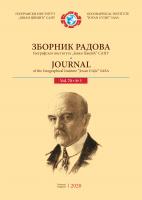UTILIZATION OF HOT SPOT ANALYSIS IN THE DETECTION OF SPATIAL DETERMINANTS AND CLUSTERS OF THE SPANISH FLU MORTALITY
UTILIZATION OF HOT SPOT ANALYSIS IN THE DETECTION OF SPATIAL DETERMINANTS AND CLUSTERS OF THE SPANISH FLU MORTALITY
Author(s): Suzana Lović Obradović, Vladimir Krivošejev, Anatoly A. YamashkinSubject(s): Geography, Regional studies, Physical Geopgraphy
Published by: Географски институт »Јован Цвијић« САНУ
Keywords: historical demography; mortality spatial patterns; hot spot analysis; Valjevo Srez.
Summary/Abstract: The Spanish flu appeared at the end of the First World War and spread around the world in three waves: spring-summer in 1918, which was mild; autumn fatal wave, in the same year; and winter wave in 1919, which also had great consequences. From the United States of America, as the cradle of its origin, the Spanish flu spread to all the inhabited continents, and it did not bypass Serbia either. Research on the Spanish flu, as the deadliest and most widespread pandemic in the human history, was mostly based on statistical researches. The development of the geographic information systems and spatial analyses has enabled the implementation of the information of location in existing researches, allowing the identification of the spatial patterns of infectious diseases. The subject of this paper is the spatial patterns of the share of deaths from the Spanish flu in the total population in Valjevo Srez (in Western Serbia), at the settlement level, and their determination by the geographical characteristics of the studied area—the average altitude and the distance of the settlement from the center of the Srez. This paper adopted hot spot analysis, based on Gi*statistic, and the results indicated pronounced spatial disparities (spatial grouping of values), for all the studied parameters. The conclusions derived from the studying of historical spatial patterns of infectious diseases and mortality can be applied as a platform for defining measures in the case of an epidemic outbreak with similar characteristics.
Journal: Зборник радова Географског института "Јован Цвијић" САНУ
- Issue Year: 70/2020
- Issue No: 3
- Page Range: 289-297
- Page Count: 9
- Language: English

